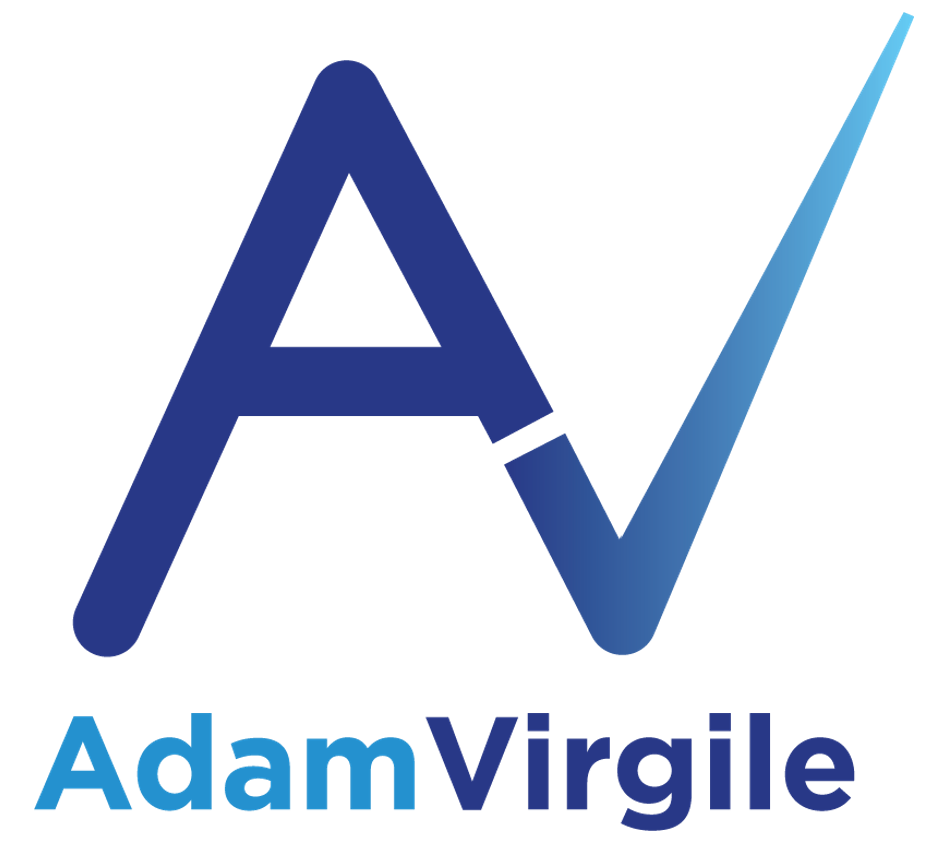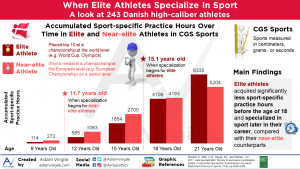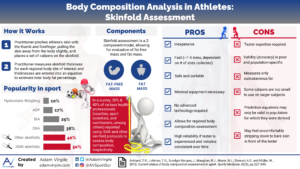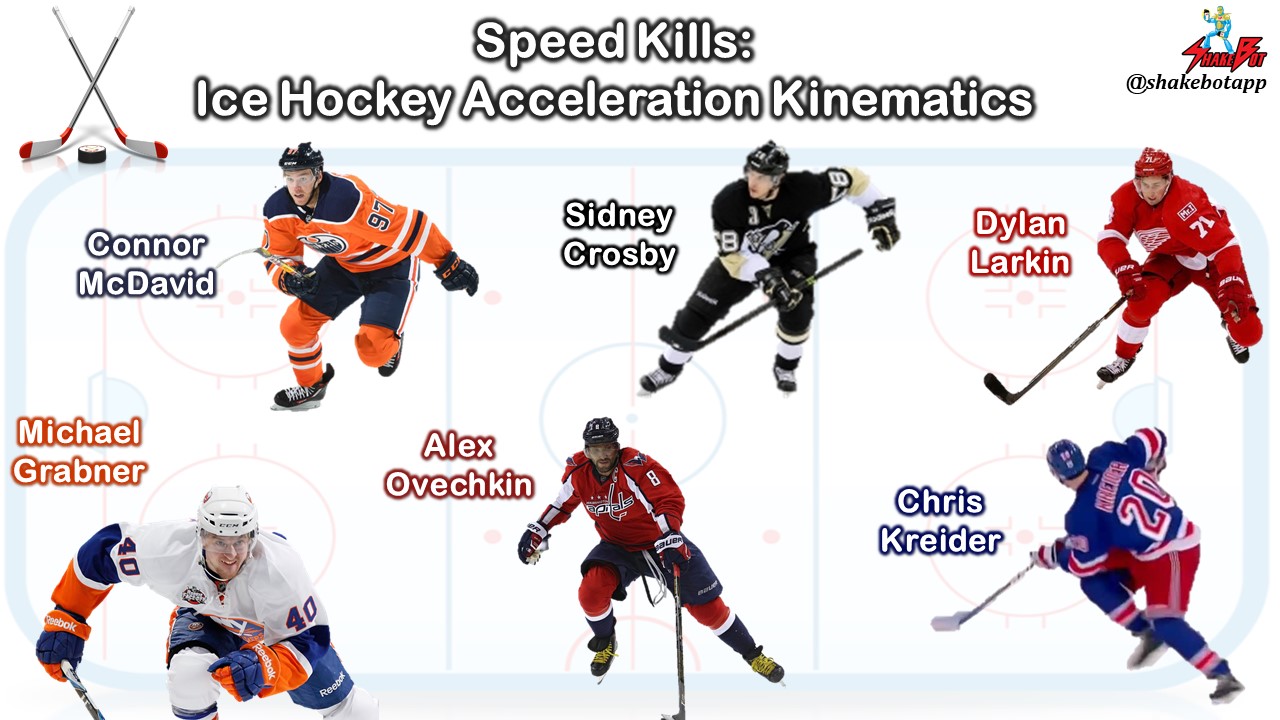The importance of physical and psychosocial health in youth cannot be overstated. This article reviews how early sport specialization impacts these factors in youth athletes.
In Case You Missed It…
If you haven’t read Part 1 and Part 2 of this article series on early sport specialization, I advise finding a bit of time to do so. You can view them here and here… and you can thank me later.
Part 1: The odds of becoming a collegiate or professional athlete, according to research.
Part 2: Whether or not early sport specialization leads to long-term athletic success.
Now, onto the current article:
Injury Risk: Beware Rapid Times of Growth
In various cohorts, early sport specialization has been associated with increased risk for injury [1-14], especially injury with overuse pathology [3-6, 10, 13].
The adolescent growth spurt, typically occurring between the ages of 10-16 in males, is a critical period for athletic development. It is characterized by a rapid period of physical growth, and has been associated with increased injury risk in gymnasts [15]. During early adolescence, the high degree of repetitive physical loading required in sports such as baseball, gymnastics, and running, or mechanical stresses of sports such as football and ice hockey, are thought to exceed the limits of the apophysis and physis (growth plates), resulting in increased injury risk [16-18]. The elevated rate of ulnar collateral ligament injuries in baseball pitchers, and traumatic knee injuries (i.e. ACL tears) in younger athletes, are oftentimes attributed to the higher rate of early single sport specialization and resulting overuse [19-23]. Similarly, playing ice hockey at an elite level during childhood was associated with an increased risk for femoroacetabular impingement (cam-type deformity) and hip pain after physeal closure [25]. The repetitive stresses through the hip from early specialization in ice hockey is thought to affect the long-term physis and apophysis alterations in the femur [24-26].
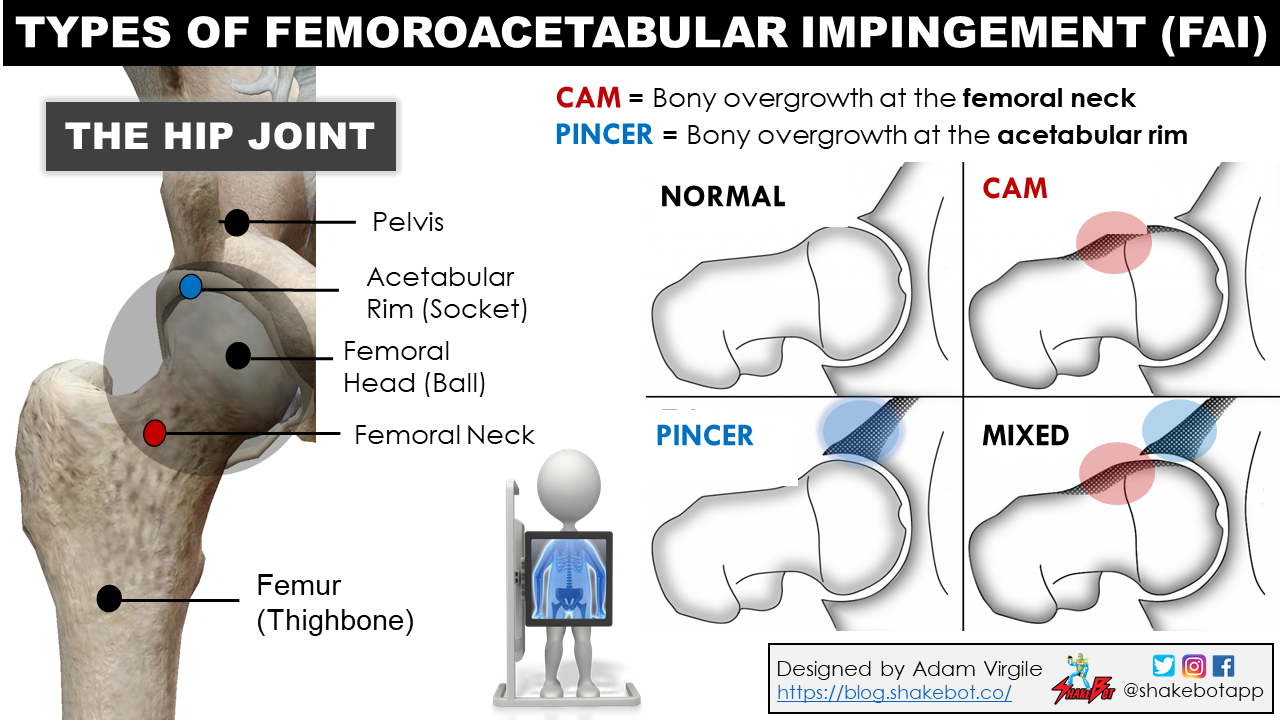
Muller et al. (2017) observed that elite youth alpine skiers (9-14 years old) who were further away from their most rapid rate of growth (i.e. peak height velocity) were more likely to miss fewer days of training due to injuries compared with their more mature counterparts [27]. In elite soccer players, Van der Sluis et al. (2015) found an increase in traumatic and overuse injury incidence from the year prior, to the year of, most rapid adolescent growth (i.e. peak height velocity), [28]. Also, in elite male youth soccer players, Kemper et al. (2015) found that rapid growth in stature ?0.6 cm, and an increased BMI ?0.3 kg/m2 per month, were significant predictors of injury [29]. Similarly, in an observation of injury rates and severities in elite soccer players aged 11-18 years old, Read et al. (2018) observed the greatest time loss per injury was in the U14-U15 age groups (under 14 years old and 15 years old, respectively), with the highest rate of severe injuries in the U15 age group; the greatest increases in stature, leg length and body mass were also occurring in the U14 and U15 age groups [30].
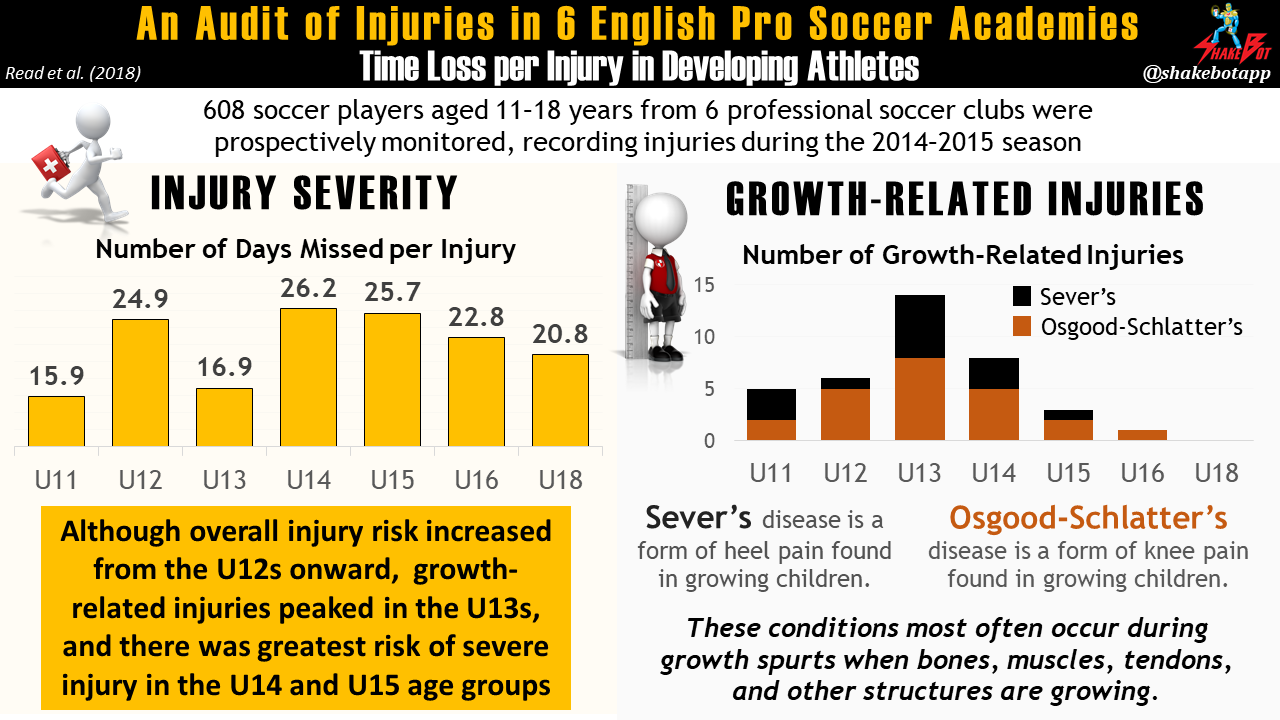
The adolescent growth spurt appears to be a period of youth physical development that warrants special attention. The elevated injury risk associated during this time period is alarming, particularly in young athletes who are specialized in a single sport, due to the consistent exposure to similar, repetitive patterns of physical loading and/or mechanical stress.
Overall Injury Risk
Rugg et al. (2018) investigated the injuries sustained by a group of NBA first round draft picks between 2008-2015 [8]. The authors found that players who were multi-sport athletes in high school were less likely to sustain a major injury during their careers, played in a higher percentage of games, and ultimately had greater longevity in the NBA, compared with their specialized counterparts [8]. Only 25% of multi-sport players sustained a major injury during their NBA careers, compared with 43% of the specialized players.

McGuine et al. (2017) evaluated lower extremity injuries in 1,544 high school athletes [9]. Athletes who were classified with a moderate or high sport specialization were more likely to sustain lower extremity injuries, compared with athletes with low specialization [9]. Similarly, Post et al. (2017) surveyed 2,011 youth athletes on their specialization status and injury history [11]. Highly specialized youth athletes were more likely to report a previous injury of any kind, or an overuse injury, in the previous year compared with athletes in the low specialization group [11]. Wilhelm et al. (2017) surveyed 102 professional baseball players about their childhood sport specialization and injury history, as well [14]. Players who specialized in baseball before high school reported more serious injuries during their professional baseball careers than those who did not [14]. In adolescent female athletes, there are multiple reports associating increased likelihood for knee pain and injury with early sport specialization [10, 12].
In a survey conducted on 1190 youth athletes (7-18 years old), Jayanthi et al. (2015) found that single sport specialization was a risk factor for overuse injury, independent of training volume [1]. Highly specialized athletes were nearly twice as likely to sustain serious overuse injuries (requiring >1 month rest from sports), compared with their non-specialized counterparts. Additionally, there appeared to be a dose-dependent effect of the degree of sports specialization to the subsequent risk of injury, overuse injury, and serious overuse injury; the higher degree of sport specialization, the higher the risk for subsequent injury [1].
A recent meta-analysis by Bell et al. (2018) also observed this dose-dependent response between degree of sport specialization and overuse injury risk [31]. Athletes with a high degree of sport specialization were at greatest risk for overuse injury, followed by those with moderate specialization, and low specialization, in that order [31].
Athlete Burnout and Dropout
Athlete burnout is often caused by physical factors, social psychological factors, or a combination of the two [4]. Smith (1983) defines burnout as a “response to chronic stress” in which a young athlete ceases to participate in a previously enjoyable activity [32]. When young athletes “burn out”, they withdraw from the sport because they feel it is no longer possible to meet the physical and/or psychological demands of that sport [33-35]. Social psychological factors may include; striving for perfection, the feeling of missing out on things peers are experiencing, or excessive coach and/or parental pressure to perform. Physical factors may include overtraining or lack of sleep [4].
Early sport specialization has been associated with signs and symptoms of athlete burnout, which can result in dropout from sport, altogether [35-42]. Increased stress, increased anxiety, perfectionism, amotivation, lack of intrinsic motivation, lack of commitment, peer pressure, and decreased enjoyment have all been associated with athlete burnout [43-51]. In their review of athlete burnout, DeFreese et al. (2015) identify the key variables relating to burnout, and present strategies to prevent/treat it [35]. Along with ensuring that the sporting environment promotes support and autonomy, the authors suggest that the athlete should investigate other sport and non-sport activities as means of personal exploration and validation of their sport involvement [35].
High-Risk Burnout Candidates
Athletes are high-risk burnout candidates when they are committed to sport because they feel they are required to be involved (entrapment reasons), as opposed to wanting to be involved (attraction reasons), [50]. Most likely, feelings of entrapment result from a combination of (1) lack of control, (2) unidimensional identity, and (3) questioning whether sports success is worth the costs and sacrifices of missing out on opportunities to participate in experiences with their peers [35].
Adolescence should be a time where youth athletes develop multifaceted identities and meaningful control over their lives through exploring various roles, while also developing increased autonomy and independence [39, 50, 51]. The social construct of early sport specialization may not allow an athlete the time and space to develop in an age-appropriate manner. Although athletes may initially choose to participate in sport for attraction-related reasons, control of their subsequent participation can be appropriated by coaches, parents, and peers. The very nature of commitment to one intensive sport prevents youth athletes from exploring other opportunities. The coinciding isolation from their peers and unidimensional focus on athletics strips away the athlete’s identity exploration, which can quickly result in reduced attraction for sport.

A Few Common Causes of Burnout
Burnout-prone athletes may, initially, participate in sport for attraction-related reasons (i.e. they enjoy the benefits and opportunities the sport has to offer). The sport can, quickly, become far less attractive when its high costs (i.e. sacrificing too much for sport) and insufficient benefits (i.e. diminished meaning of sport success) are recognized [50]. However, these athletes may not be able to cease participation because they become entrapped by a lack of personal control (via pressure from peers, coaches, and parents) and have already developed athlete-centric, unidimensional identities [39, 50, 51].
One thing is for certain; athlete burnout can be multifaceted, and may include factors such as increased stress, increased anxiety, perfectionism, amotivation, lack of intrinsic motivation, lack of commitment and decreased enjoyment [43-49].
Early sport specialization can predispose the young athlete to many, if not all, of these burnout associations. In fact, multiple reports suggest that athletes who specialize in sport early in adolescence are more likely to burnout, get hurt, withdraw from sport, and sacrifice long-term athletic development [37, 52-56].
In the next article in this series, I’ll offer 5 simple strategies to help prevent burnout in youth athletes.
Reference
- Jayanthi, N.A., LaBella, C.R., Fischer, D., Pasulka, J. and Dugas, L.R., 2015. Sports-specialized intensive training and the risk of injury in young athletes: a clinical case-control study. The American journal of sports medicine, 43(4), pp.794-801.
- Jayanthi, N., Pinkham, C., Dugas, L., Patrick, B. and LaBella, C., 2013. Sports specialization in young athletes: evidence-based recommendations. Sports health, 5(3), pp.251-257.
- Feeley, B.T., Agel, J. and LaPrade, R.F., 2016. When is it too early for single sport specialization?. The American journal of sports medicine, 44(1), pp.234-241.
- LaPrade, R.F., Agel, J., Baker, J., Brenner, J.S., Cordasco, F.A., Côté, J., Engebretsen, L., Feeley, B.T., Gould, D., Hainline, B. and Hewett, T.E., 2016. AOSSM early sport specialization consensus statement. Orthopaedic journal of sports medicine, 4(4), p.2325967116644241.
- Smucny, M., Parikh, S.N. and Pandya, N.K., 2015. Consequences of single sport specialization in the pediatric and adolescent athlete. Orthopedic Clinics, 46(2), pp.249-258.
- DiFiori, J.P., Benjamin, H.J., Brenner, J.S., Gregory, A., Jayanthi, N., Landry, G.L. and Luke, A., 2014. Overuse injuries and burnout in youth sports: a position statement from the American Medical Society for Sports Medicine. Br J Sports Med, 48(4), pp.287-288.
- DiFiori, J.P., Güllich, A., Brenner, J.S., Côté, J., Hainline, B., Ryan, E. and Malina, R.M., 2018. The NBA and Youth Basketball: Recommendations for Promoting a Healthy and Positive Experience. Sports Medicine, pp.1-13.
- Rugg, C., Kadoor, A., Feeley, B.T. and Pandya, N.K., 2018. The Effects of Playing Multiple High School Sports on National Basketball Association Players’ Propensity for Injury and Athletic Performance. The American journal of sports medicine, 46(2), pp.402-408.
- McGuine, T.A., Post, E.G., Hetzel, S.J., Brooks, M.A., Trigsted, S. and Bell, D.R., 2017. A prospective study on the effect of sport specialization on lower extremity injury rates in high school athletes. The American journal of sports medicine, 45(12), pp.2706-2712.
- O’Kane, J.W., Neradilek, M., Polissar, N., Sabado, L., Tencer, A. and Schiff, M.A., 2017. Risk factors for lower extremity overuse injuries in female youth soccer players. Orthopaedic journal of sports medicine, 5(10), p.2325967117733963.
- Post, E.G., Trigsted, S.M., Riekena, J.W., Hetzel, S., McGuine, T.A., Brooks, M.A. and Bell, D.R., 2017. The association of sport specialization and training volume with injury history in youth athletes. The American journal of sports medicine, 45(6), pp.1405-1412.
- Hall, R., Foss, K.B., Hewett, T.E. and Myer, G.D., 2015. Sport specialization’s association with an increased risk of developing anterior knee pain in adolescent female athletes. Journal of sport rehabilitation, 24(1), pp.31-35.
- Fabricant, P.D., Lakomkin, N., Sugimoto, D., Tepolt, F.A., Stracciolini, A. and Kocher, M.S., 2016. Youth sports specialization and musculoskeletal injury: a systematic review of the literature. The Physician and sportsmedicine, 44(3), pp.257-262.
- Wilhelm, A., Choi, C. and Deitch, J., 2017. Early sport specialization: Effectiveness and risk of injury in professional baseball players. Orthopaedic journal of sports medicine, 5(9), p.2325967117728922.
- Caine, D., Cochrane, B., Caine, C. and Zemper, E., 1989. An epidemiologic investigation of injuries affecting young competitive female gymnasts. The American journal of sports medicine, 17(6), pp.811-820.
- Caine, D., DiFiori, J. and Maffulli, N., 2006. Physeal injuries in children’s and youth sports: reasons for concern?. British journal of sports medicine, 40(9), pp.749-760.
- DiFiori, J.P., 2010. Evaluation of overuse injuries in children and adolescents. Current sports medicine reports, 9(6), pp.372-378.
- DiFiori, J.P., 2010. Overuse injury of the physis: a “growing” problem.
- American Sports Medicine Institute. Position statement for youth baseball pitchers. 2013. Available at: http://www.asmi.org/research.php?page5research §ion5positionStatement. Accessed October 17, 2014.
- Petty DH, Andrews JR, Fleisig GS, et al. Ulnar collateral ligament reconstruction in high school baseball players: clinical results and injury risk factors. Am J Sports Med 2004;32:1158–64.
- Savoie FH 3rd, Trenhaile SW, Roberts J, et al. Primary repair of ulnar collateral ligament injuries of the elbow in young athletes: a case series of injuries to the proximal and distal ends of the ligament. Am J Sports Med 2008;36:1066–72.
- Zell M, Dwek JR, Edmonds EW. Origin of the medial ulnar collateral ligament on the pediatric elbow. J Child Orthop 2013;7:323–8.
- Larsen N, Moisan A, Witte D, et al. Medial ulnar collateral ligament origin in children and adolescents: an MRI anatomic study. J Pediatr Orthop 2013;33:664–6
- Philippon, M.J., Ho, C.P., Briggs, K.K., Stull, J. and LaPrade, R.F., 2013. Prevalence of increased alpha angles as a measure of cam-type femoroacetabular impingement in youth ice hockey players. The American journal of sports medicine, 41(6), pp.1357-1362.
- Siebenrock, K.A., Kaschka, I., Frauchiger, L., Werlen, S. and Schwab, J.M., 2013. Prevalence of cam-type deformity and hip pain in elite ice hockey players before and after the end of growth. The American journal of sports medicine, 41(10), pp.2308-2313.
- Zadpoor, A.A., 2015. Etiology of femoroacetabular impingement in athletes: a review of recent findings. Sports Medicine, 45(8), pp.1097-1106.
- Müller, L., Hildebrandt, C., Müller, E., Fink, C. and Raschner, C., 2017. Long-term athletic development in youth alpine ski racing: The effect of physical fitness, ski racing technique, anthropometrics and biological maturity status on injuries. Frontiers in physiology, 8, p.656.
- Van der Sluis, A., Elferink-Gemser, M.T., Brink, M.S. and Visscher, C., 2015. Importance of peak height velocity timing in terms of injuries in talented soccer players. International journal of sports medicine, 36(04), pp.327-332.
- Kemper, G.L.J., Van der Sluis, A., Brink, M.S., Visscher, C., Frencken, W.G.P. and Elferink-Gemser, M.T., 2015. Anthropometric injury risk factors in elite-standard youth soccer. International journal of sports medicine, 36(13), pp.1112-1117.
- Read, P.J., Oliver, J.L., De Ste Croix, M.B., Myer, G.D. and Lloyd, R.S., 2018. An audit of injuries in six English professional soccer academies. Journal of sports sciences, 36(13), pp.1542-1548.
- Bell, D.R., Post, E.G., Biese, K., Bay, C. and McLeod, T.V., 2018. Sport Specialization and Risk of Overuse Injuries: A Systematic Review With Meta-analysis. Pediatrics, p.e20180657.
- Smith RE. Toward a cognitive-affective model of athletic burnout. J Sport Psychol. 1986;8:36–50.
- Gould, D., 1993. Intensive sport participation and the prepubescent athlete: Competitive stress and burnout. Intensive participation in children’s sports, pp.19-38.
- Goodger, K., Gorely, T., Lavallee, D. and Harwood, C., 2007. Burnout in sport: A systematic review. The sport psychologist, 21(2), pp.127-151.
- DeFreese, J.D., Raedeke, T.D. and Smith, A.L., 2015. Athlete burnout: an individual and organizational phenomenon. Applied sport psychology: Personal growth to peak performance, 444.
- Fraser-Thomas, J., Côté, J. and Deakin, J., 2008. Examining adolescent sport dropout and prolonged engagement from a developmental perspective. Journal of applied sport psychology, 20(3), pp.318-333.
- Gould, D., Tuffey, S., Udry, E. and Loehr, J., 1996. Burnout in competitive junior tennis players: I. A quantitative psychological assessment. The sport psychologist, 10(4), pp.322-340.
- Strachan, L., Côté, J. and Deakin, J., 2009. “Specializers” versus “samplers” in youth sport: comparing experiences and outcomes. The sport psychologist, 23(1), pp.77-92.
- Coakley, J., 1992. Burnout among adolescent athletes: A personal failure or social problem?. Sociology of sport journal, 9(3), pp.271-285.
- Wall, M. and Côté, J., 2007. Developmental activities that lead to dropout and investment in sport. Physical education and sport pedagogy, 12(1), pp.77-87.
- Law, M.P., Côté, J. and Ericsson, K.A., 2007. Characteristics of expert development in rhythmic gymnastics: A retrospective study. International journal of sport and exercise psychology, 5(1), pp.82-103.
- Jowett, G.E., Hill, A.P., Hall, H.K. and Curran, T., 2013. Perfectionism and junior athlete burnout: The mediating role of autonomous and controlled motivation. Sport, Exercise, and Performance Psychology, 2(1), p.48.
- Raedeke, T.D. and Smith, A.L., 2001. Development and preliminary validation of an athlete burnout measure. Journal of sport and exercise psychology, 23(4), pp.281-306.
- Schmidt, G.W. and Stein, G.L., 1991. Sport commitment: A model integrating enjoyment, dropout, and burnout. Journal of sport and exercise psychology, 13(3), pp.254-265.
- Lonsdale, C., Hodge, K. and Rose, E., 2009. Athlete burnout in elite sport: A self-determination perspective. Journal of sports sciences, 27(8), pp.785-795.
- Gustafsson, H., Skoog, T., Davis, P., Kenttä, G. and Haberl, P., 2015. Mindfulness and its relationship with perceived stress, affect, and burnout in elite junior athletes. Journal of Clinical Sport Psychology, 9(3), pp.263-281.
- Gustafsson, H., Martinent, G., Isoard-Gautheur, S., Hassmén, P. and Guillet-Descas, E., 2018. Performance based self-esteem and athlete-identity in athlete burnout: A person-centered approach. Psychology of Sport and Exercise.
- Hall, H.K., Hill, A.P. and Appleton, P.R., 2012. Perfectionism: A foundation for sporting excellence or an uneasy pathway toward purgatory?.
- Gustafsson, H., DeFreese, J.D. and Madigan, D.J., 2017. Athlete burnout: Review and recommendations. Current opinion in psychology, 16, pp.109-113
- Raedeke, T.D., 1997. Is athlete burnout more than just stress? A sport commitment perspective. Journal of sport and exercise psychology, 19(4), pp.396-417.
- Gustafsson, H., Hassmén, P., Kenttä, G. and Johansson, M., 2008. A qualitative analysis of burnout in elite Swedish athletes. Psychology of sport and exercise, 9(6), pp.800-816
- Barynina, I.I. and Vaitsekhovskii, S.M., 1992. The aftermath of early sports specialization for highly qualified swimmers. Fitness and Sports Review International, 27(4), pp.132-133.
- Wall, M. and Côté, J., 2007. Developmental activities that lead to dropout and investment in sport. Physical education and sport pedagogy, 12(1), pp.77-87.
- Malina, R.M., 2010. Early sport specialization: roots, effectiveness, risks. Current sports medicine reports, 9(6), pp.364-371.
- McClelland, J.J., 2016. Early Sport Specialization: Overuse Injury and Burnout.
- Fraser-Thomas, J., Côté, J. and Deakin, J., 2008. Examining adolescent sport dropout and prolonged engagement from a developmental perspective. Journal of applied sport psychology, 20(3), pp.318-333.
